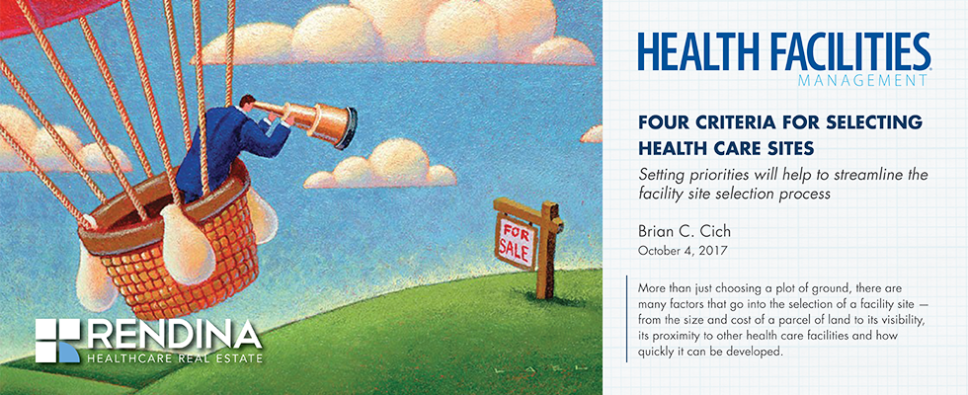Brian Cich, COO of Rendina, recently authored an article on site selection strategies for hospitals and healthcare systems. The article, “Four criteria for selecting health care sites” was published on October 4, 2017 on Health Facilities Management’s website. The article can be read in full from the link below and will be available in the October edition of HFM’s print publication.
Click Here for the Full Article
FOUR COMMON CRITERIA
- Location, Location, Location
- Size Matters
- Cost Controls
- Speed to Opening
LOCATION, LOCATION, LOCATION
When setting priorities for a facility site, location is typically one of the most important factors to consider. Many projects are borne out of an organization’s strategic need to expand its services and presence into a geographic area — a town or neighborhood where their existing or potential patients live and work.
SIZE MATTERS
The size of a development site is another fundamentally important factor. Ideally, health care organizations should choose a plot of land that can accommodate their current and projected square-footage needs, parking infrastructure and other considerations without a lot of excess acreage. Unless the organization has bigger plans for expansion, there’s no need to overbuy.
If an organization is partnering with a health care real estate development company, that partner should be able to estimate how much land a facility will need to accommodate the building’s square footage, parking, drainage and other considerations, such as potential future growth. This allows an organization to narrow its property choices to those that are the right size.
COST CONTROLS
Property location and size are among the primary drivers of property costs. All other factors being equal, properties in the most desirable, convenient locations will cost more than their counterparts in more out-of-the way locales. In that way, an organization with a strict or tight budget may have to compromise on property location, size or both to make their vision a reality.
Additionally, the decision to purchase or ground lease a property can have a modest impact on site costs. Though there can be some economic benefit to ground leasing a property, owning and fully controlling the property is often a better decision for an organization in the long run. Generally, when layering in the land purchase cost and long-term ground lease expense, the difference usually is not significant.
SPEED TO OPENING
An organization also may evaluate sites based on how quickly it would be able to complete the development and open its doors. Perhaps the organization wants to serve a new area quickly or perhaps it simply can’t wait any longer for the new or additional space.
When speed is important, the health care organization or its development partner may narrow the site search to include only those properties that are ready for medical development. That means properties that are the right size, have the proper zoning and no restrictions — allowing development to begin without an extended approval process or time-consuming zoning code changes or variances.






















